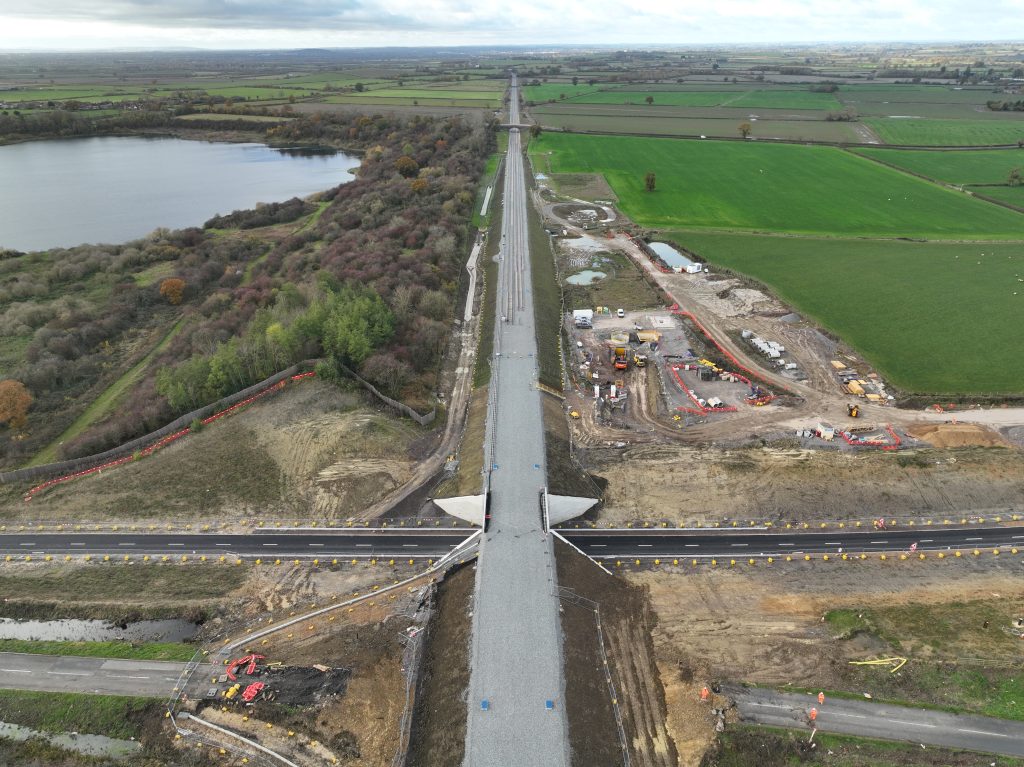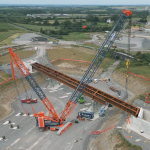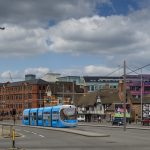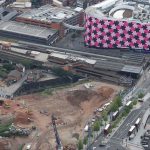Sector - Transport & Infrastructure
HS2 completes East-West Rail works at Calvert

HS2 has completed the last section of earthworks that will carry East West Rail (EWR) services between Oxford and Cambridge over the new high-speed line, near the village of Calvert in Buckinghamshire.
To reduce disruption for the community and speed up construction, HS2 contractors have built two bridges, one underpass and 3.4km of adjacent earthworks for EWR where the two projects cross.
The main bridge deck of the intersection bridge – which weighs the same as 25 double decker buses – will carry local and regional trains over the top of one of the longest cuttings on the HS2 project. Two smaller bridges and one underpass will take local roads and a footpath across EWR.
Joint working was particularly important during the realignment of Gawcott Road, when problems emerged with a gas main diversion. HS2 worked closely with EWR throughout, so that the installation of communications cables – required to allow EWR to enter service on time – could continue around the delayed utility work.
With the large bridges and earthworks handed over, HS2 contractors can now focus on completing the Calvert cutting – which runs roughly north-south and will stretch for more than 2 miles.
Once complete, HS2 will link London with Birmingham and the West Midlands, freeing up space on the most congested part of the West Coast Mainline and boosting growth around the four major station sites.
HS2 Ltd’s Senior Project Manager Hugo Rebelo said: “HS2 will dramatically improve journeys between London, Birmingham and the major cities of the north but it’s vital that we also maintain and enable links for local communities during construction.
“That’s why we have been working closely with the East West Rail Alliance to get this crucial section into position and I’d like to thank everyone involved in getting us to this important moment for both our projects.”
The earthworks and bridges were delivered by HS2’s main works contractor EKFB – a group made up of Eiffage, Kier, Ferrovial Construction and Bam Nuttall. EWR is being delivered by the East West Rail Alliance which is made up of Network Rail, Atkins, Laing O’Rourke and VolkerRail.
The milestone also allows the East West Rail Alliance to begin laying track which is scheduled for completion early 2024.
Weighing in at over 315 tonnes, the main bridge was assembled on site and lifted into position last year with a 600-tonne crawler crane. Made of weathering steel, the 35m long bridge is designed to naturally age over time to a dark brown colour to help match the tone of the surrounding countryside.
The main bridges and earthworks were handed over in sections over the last year, to integrate and optimise the delivery of both programmes, with the final area – an 80 metre section of earthworks – handed over this week. The bridge carrying Addison Road is of a similar design (at a smaller scale) as the main intersection bridge, whilst Gawcott Road crosses the alignment in a reinforced concrete box type underpass.
In the long term, the area will also be home to HS2’s Infrastructure Maintenance Depot, which is expected to create around 180 jobs locally. Work is also progressing on the Perry Hill overbridge to the north of the site with the steel beams and concrete deck now installed. The 99-metre long structure will take a local road over HS2 at a point where the access tracks leading into the IMD split off from the mainline.
A large area of landscaping and new woodland planting will screen the depot from the nearby village of Steeple Claydon, with around 15,000 trees and 20,000 shrubs set to be planted amid new woodland paths, ponds and other wildlife habitats. An additional footbridge will be installed separately, next year.
To the south, around 685,000 cubic metres of material is being excavated to create the Calvert cutting which will be up to 9.7m deep and wide enough to potentially allow extra local railway lines to be added alongside the HS2 main line at a later date to link Aylesbury with EWR.
Around 99% of the material EKFB are excavating will be kept within the HS2 site and moved using a dedicated network of haul roads to avoid extra traffic on public roads. It will then be reused for embankments, noise barriers and landscaping. Over the last 32 months, EKFB has shifted more than 28 million cubic metres of material across the 80km between the Chilterns and South Warwickshire.
If you would like to read more stories like this, then please click here
Related Articles
More Transport & Infrastructure News
- Belfast Harbour Secured as £100 Million Hub for Major Offshore Wind Projects
10 Dec 25
Belfast Harbour is set to become the primary assembly and construction hub for two of
- Government Earmarks Rail-Adjacent Land for Accelerated Housing Development
9 Dec 25
The UK government has announced a significant package of planning reforms designed to accelerate the
- Jacobs to deliver advisory services to public sector clients through 2027
3 Dec 25
Jacobs has been named as a supplier on the Crown Commercial Service’s (CCS) Management Consultancy






